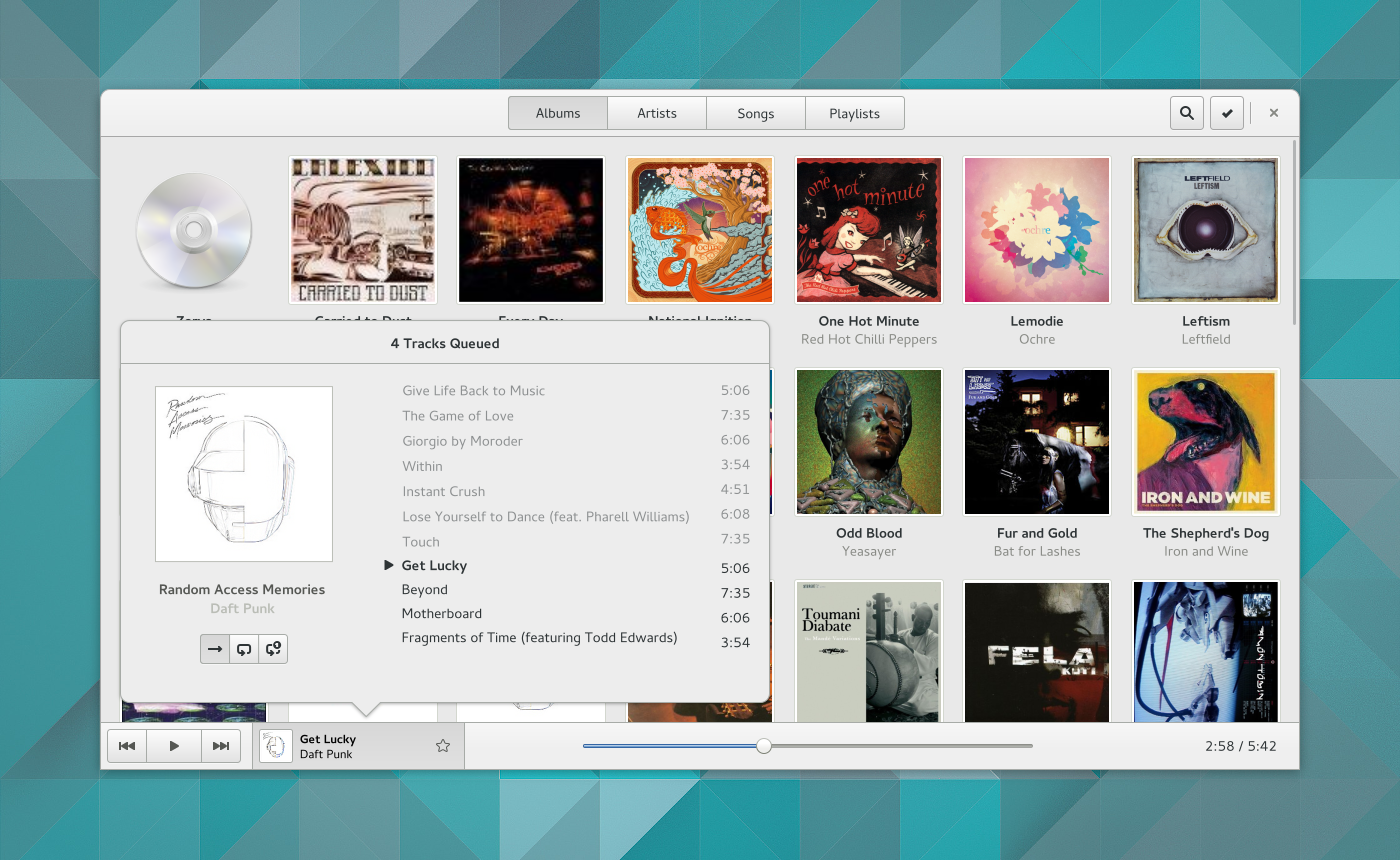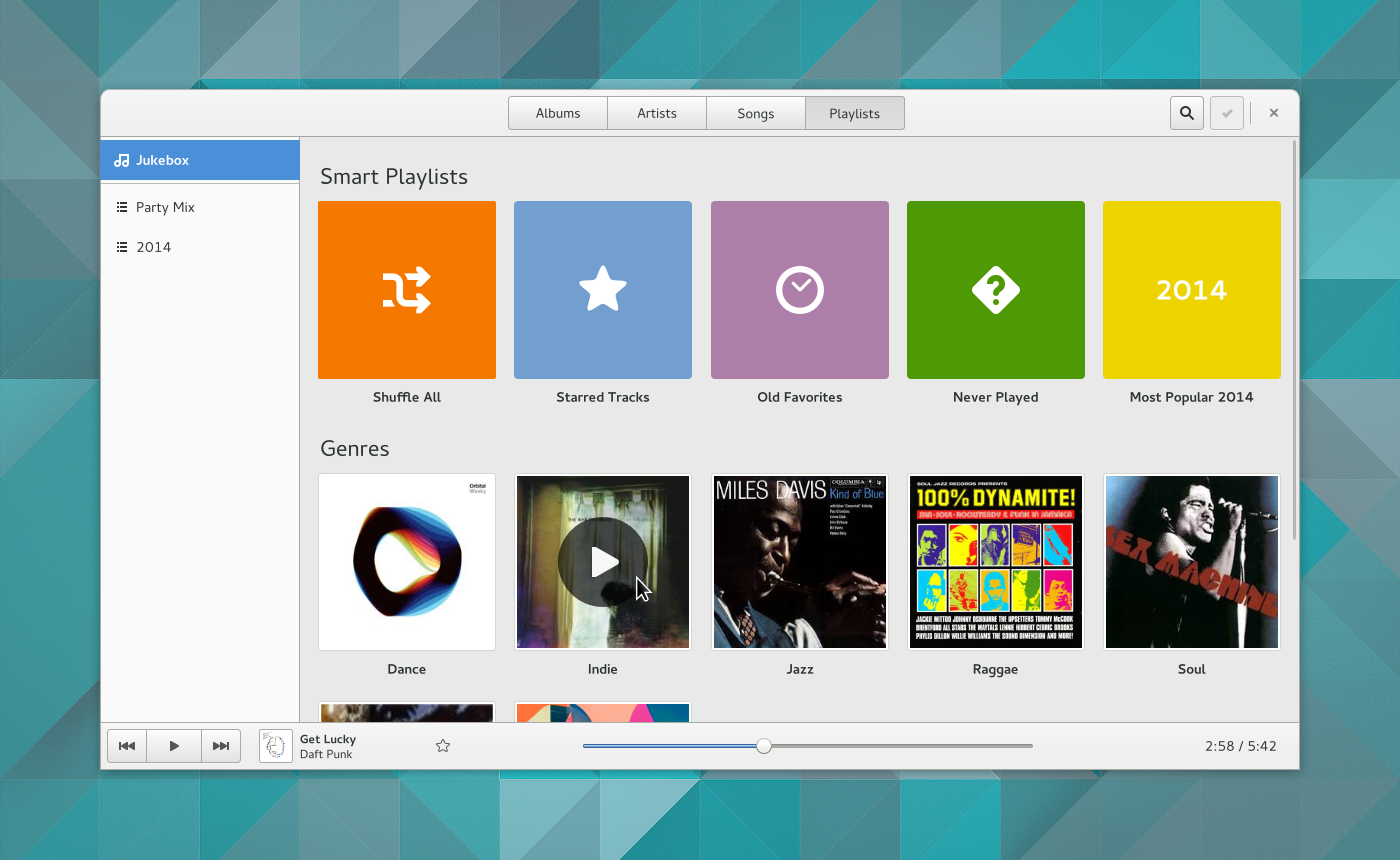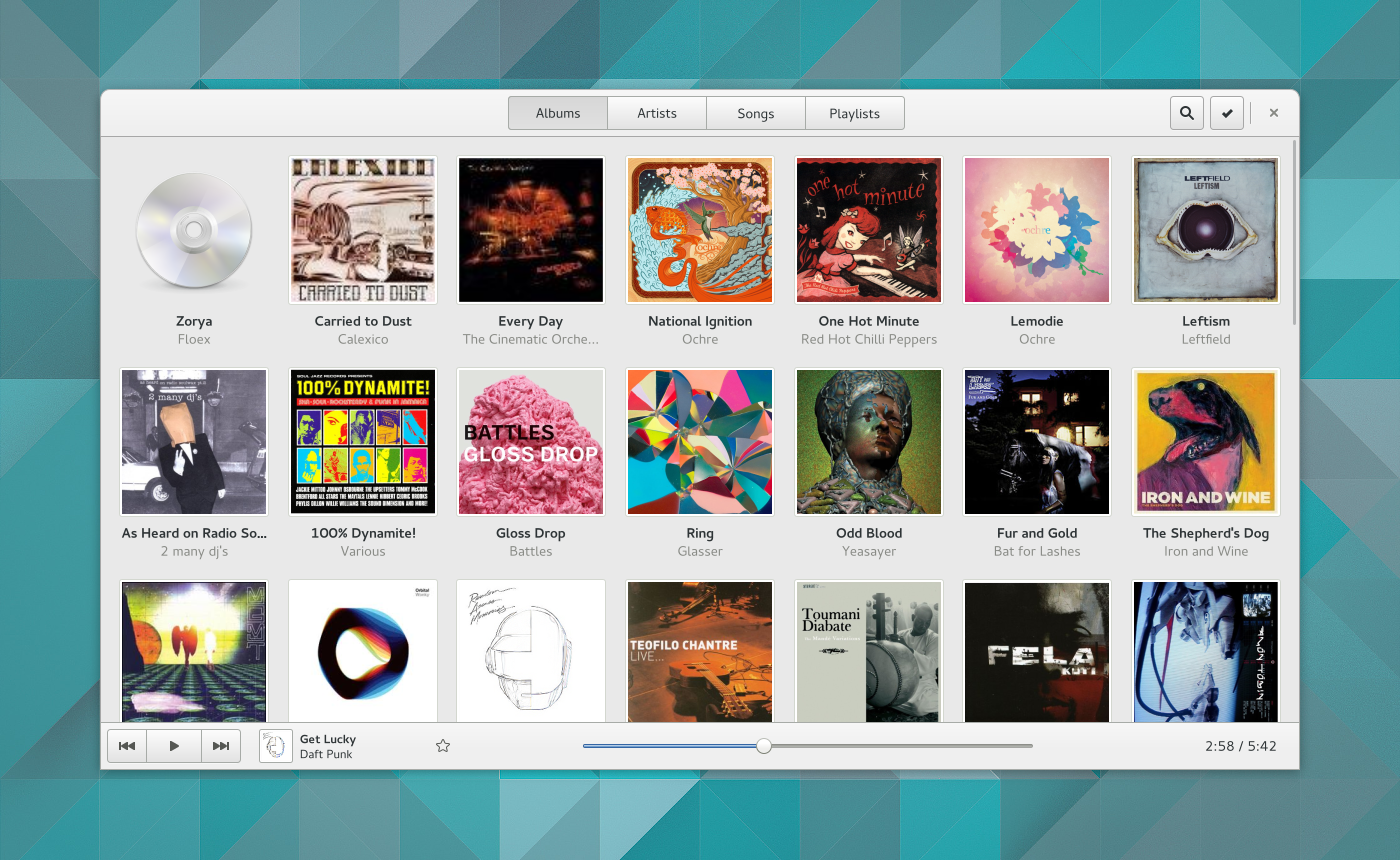I’ve been a bit quiet about GNOME’s applications of late. This isn’t because nothing has been happening, though – quite the opposite. We’ve been steadily working away behind the scenes, and our application designs have evolved considerably.
This is the first in what will be a series of posts, in which I’ll summarise recent application design changes, as well as plans for the future. In this post, I’ll be focusing on Music.
We’re at a critical point with many of the core apps. There is still a fair amount of polish work to be done, and interesting features are missing in some cases. However, much of the basic functionality is in place, so we have a good platform to build on. We are a position to make a lot of GNOME’s apps truly great: it’s just a matter of making the final ten yards.
Of course, we need help to make GNOME’s apps really shine, so if you want to get involved with any of the initiatives I’ll be describing, please get in touch.
Music: where things stand
A number of features have landed in Music over the past couple of cycles, so that it now has a good basic feature set. There is a really nice search interface now, for example, and smart playlists were recently introduced in 3.16.
I personally use Music as my primary music player, and I really appreciate how it offers a clean view of my music collection, particularly with the nice grid of album covers. I’m very happy to have a music player that doesn’t look like a database front-end. :)
But what about plans for the future?
Play Queue
The first new feature that we have planned for Music is a new play queue interface. This is intended to give you quick access to what’s currently playing. You can also star tracks that are in the queue, such as the song you just listened to.
The new play queue design aims to improve the interaction around shuffle and repeat. We want to make sure that these only act on the current play queue, so that you don’t accidentally leave shuffle on forever (this will be possible through the smart playlists, if it’s what you want), and it allows shuffle and repeat to be used temporarily for a particular music selection.
Even smarter playlists
As I already mentioned, smart playlists landed last cycle, in 3.16. We really want to build on this functionality. I’m excited by the possibility of making smart playlists much more dynamic, so that they reflect your music collection and listening habits.
If you have a lot of jazz in your collection, we could offer special jazz playlists, or if you have been using the app for a while, we can suggest retrospective selections of tracks, such as your favourite artists from the last month or year. There’s a huge amount of scope here to create an engaging, personalised listening experience.
A first step in this work is to rework the existing UI for smart playlists.
Media import
The final new feature that I’m going to mention here is media import. While optical media isn’t as popular as it used to be, it is still important for some users, and we want to make it simple and easy to rip a CD and add it to your music collection.
Polish, polish, polish
Last but not least, we want all the core apps to provide a really polished, high quality experience. So, while there are plenty of big new features planned, refining the existing featureset is also an important goal. Many of the needed changes are quite small, and there are plenty of bugs that are marked as priorities for this cycle.
We need your help
Music has a great maintainer, in the shape of Vadim Rutkovsky, and the app is on its way to providing an excellent, modern, music experience for GNOME. That said, many of the bugs and features I’ve mentioned in this post need people to work on them. So, if you are interested in getting involved, or in helping to create an awesome music app, look no further. We’re looking for experienced developers, as well as newcomers.
For information can be found on the Music wiki page.




GNOME Music has a great potential and the UI is great, I want to like it but:
– I don’t see myself using an app that does not support Last.fm scrobblings
– the fact that it’s written in Python makes it really slow compared to Rhythmbox and unusable for “large” music collections (20000+) songs
– I have all my stats in Rhythmbox and I’m not willing to lose all my ratings, and last played times
But maybe I’m not the target group for this app.
Python is not the reason why GNOME Music chokes on big collections. I have a similar amount of songs in my music library and Quodlibet, which is made in Python, manages it gracefully (as good as Rhytmbox, if not better). I also want to love Music, but as long as it keeps choking on large libraries it’s not an option. Ah, and album-style ReplayGain support (maybe that is working now, I haven’t checked for a while).
Other than that, Music is a great piece of software :-)
I don’t think GNOME Music is slow due to Python though, Lollypop is another GTK3 music player that follows much of GNOME Music’s design and is also written in Python but is quite fast compared to GNOME Music. I’d suspect more of the blame is due the usage of Tracker in GNOME Music then Python.
Well, gnome-music is slow with 2k+ songs. But quodlibet is also python application and works really fast. So python is not a problem here.
>the fact that it’s written in Python makes it really slow
This is a popular myth and it can be easily busted by checking the speed of previous GNOME Music releases – the performance has (hopefully) improved.
Software is full of bugs and imperfect decisions – you can make it better by reporting issues and fixing them
Funny you mentioned Last.fm.
I implemented Last.fm scrobbling some time ago and submitted a pull request and then a patch to gnome-music which I think never got merged.
You can use my fork if you’re interested https://github.com/nilgradisnik/gnome-music
I see the pull request is still there https://github.com/GNOME/gnome-music/pull/5
Hi Nil! It would be great if we could finish the conversation about your patches. Bug 705070 is the best place to do this.
There are many patches and “help me help you” requests just lying around on Bugzilla for months with no response, and it is not limited to GNOME Music…
This is not a really good way to encourage people to contribute…
Music’s Bugzilla is in a good state, and Vadim is prompt at reviewing patches. I know this, because I’ve been through all the bugs personally! This is one reason why Music is a good application to get involved with.
Hi Alan. I highly appreciate what you and the rest of GNOME team did for the endless GNOME improvement. I enjoy every release of GNOME 3, there are always a lot things to cherish and GNOME is now more focus on providing its user with software that is high quality and well integrated with the environment.
I do have one question to ask.. Are there any plan to integrate lyrics column/tab to the Music app? Hopefully if it’s yes, the lyrics that’s been fetched will also be automatically saved.
And if it there is no plan, will it have a standalone app for shoewing lyrics? (Think QuickLyric for Android that can be paired with VLC).
I think such feature we can find in Amarok is a must have feature. Just my two cents.
Where would we go to start helping with this? I’m relatively new to gnome and python, but I have created an application using python on arch linux. Thanks.
Hey Uro! I’d check out some of the bugs that I linked to, like the ones we’re targeting for 3.18: https://bugzilla.gnome.org/buglist.cgi?bug_status=UNCONFIRMED&bug_status=NEW&bug_status=ASSIGNED&bug_status=REOPENED&list_id=26659&product=gnome-music&target_milestone=3.18
There’s some simple tasks there to get started on. Also, feel free to drop by the #gnome-music channel and say hi! :)
IMHO You should go for media import from filesystem (i.e. import mp3 downloaded to collection) before cd-riping. Many laptops nowadays don’t even have a cd reader. If you ask me, banshee got it properly done.
Sadly I never manged to get even a single song to show up in gnome music… my music files are on an external drive which is not mounted as ~/Music and there is no (obvious) way to make this work…
UPDATE: It looks like indexing ~/Music was not active in search settings (control center > search > seach locations) so it did not matter what I put into that directory. The app should probably check this and offer to correct the setting.
Also strange: I had even added my external music folder as a custom path for search and the path had been indexed (verified by tracker search -m) but still gnome-music did not show any music.
>The app should probably check this and offer to correct the setting
We’re preparing a new initial state screen, which would suggest a correct setting.
>the path had been indexed (verified by tracker search -m) but still gnome-music did not show any music.
GNOME Music doesn’t display other folders except XDG’s Music and Downloads by design – we don’t want to include some unrelated files.
External sources should be handled via grilo plugins, same as USB Flash drives or MTP devices.
Good news! Thanks for the information.
Looks good.
How configurable will media import be? I guess the people who still prefer CDs are the ones who have strong preferences on the technical details of how CDs are ripped. E.g. for me, secure ripping, good tagging (MusicBrainz), as well as ogg and flac suppport is essential to consider it to begin with.
Thanks,
What is really missing on the Linux desktop IMHO is a music player with proper DLNA support. Nowadays many people keep their music collection on a NAS or even store it on their mobile phone. There are many DLNA enabled output devices available like TVs, amplifiers and speakers.
Are there plans to support DLNA (to access music on a server, be a server for the local collection and support for playing music on a user selectable renderer)?
I didn’t check this properly, but GNOME Music should support UPnP/DLNA sources via Grilo. Please file an issue if some functionality is missing though
I like the GNOME desktop, but I have limited understanding why people like to reinvent the wheel. GNOME Music seems to add just another half done, feature poor music app for Linux, that no one really needs. Why not working with the people from Rhythmbox to improve the display. Add a new GNOME style frontend as an option, kill bugs…
I will certainly not give up my Rhythmbox database for this.
I think you guys should rather focus on important things like proper pdf support (annotations!!!!), mobile phone interaction, feature rich backup software, proper pdf support ( oh wait, did I mention this before ;) ) just as an example. Instead your playing in the sandbox…
Hi Mace. We spoke to the Rhythmbox maintainer in the beginning, but it was clear that he had his own vision, which is why we went our own way. And really, I don’t see a problem with having multiple music applications, if their design objectives are sufficiently different. Also, resources in Free Software aren’t interchangeable – the same people who might be interested in working on a new Music app aren’t the same people who will be interested in working on PDF support. One initiative doesn’t cancel another out.
Well. The UI looks nice, but as long as it doesn’t have basic media player features like support for online radio channels I’m sticking with Rhythmbox :)
Hey Alan,
The 2010 theme is not responsive enough. Making it a bit hard to read on my mobile. 2014 is the nicest theme, though actually changed yours to 2015. Apologies for doing without asking but not being able to read on mobile is a bit of an annoyance… tried making it look okayish, though think text is a bit big on a pc.
Thanks Olav! I was actually using a different theme, but it seems to break comments, so switched to 2010 as a short-term measure. I’ll take it up with the sysadmin crew.
Small nitpick, but “Smart playlist” sounds fancy today, but probably not so much in a couple of years when noone can remember what was supposed to be smart about them.
What about just calling it “playlist”, or “dynamic playlist” or “(automatically) generated playlist” or similar if you want to emphasize a difference?
Hi.
I’m curious why you use a sidebar for manual playlists, but stick smart lists in the grid?
Regular playlists contain a specific sequence of tracks, which are displayed on the right. This isn’t the case for smart playlists – they are magic and never-ending, so it doesn’t make sense to display their contents.
I pretty much would love to use most of the new gnome applications. They look great on screenshots but most of them simply do not work for me in reality. Gnome builders is the one and only exception.
E.g. gnome music: On one machine, it does not show a single music file I have on my machine. On the other one that part works but it is a way too slow and doesn’t feel responsive at all. At the end I rather stick with mocp or good old totem. I really hope the gnome music (and the other new core applications) can sort out such kind of issues. I like the concept and would love to see myself using the new patterns.
Hi,
They look very polished I was wondering what OS are you running if Fedora is the answer, have you changed the fonts or font-rendering ? It really looks polished.
Not using players that do not support playing music from a directory.
I think that music has a great potential, has good features but I think or well my main concern about it is the UX in personal,I don’t like rhythmbox cause the UI is not that good for me,I use Audacious as my main music player, why? Cause its simple and does the job,I don’t need Radio or last.fm,the think is that it would need a better UX and UI so it can provide what the users need,in the endless opinion of every single user I think that the Gnome team would get that balanced job of UI and UX as it has been over the years